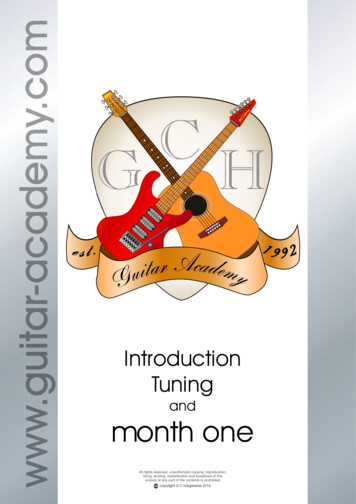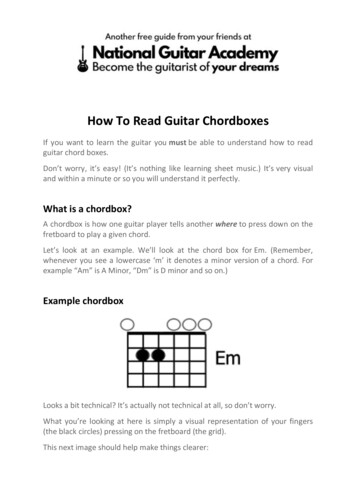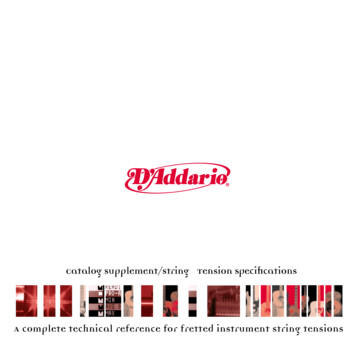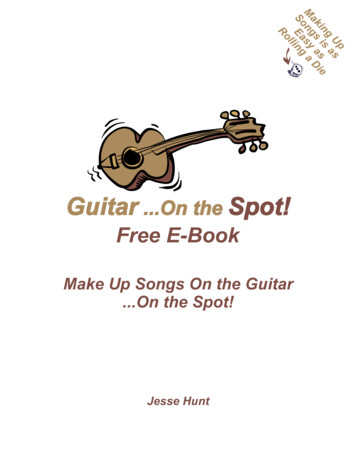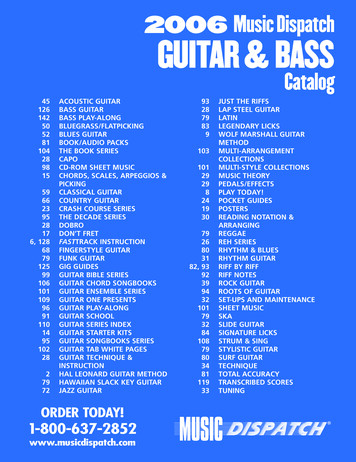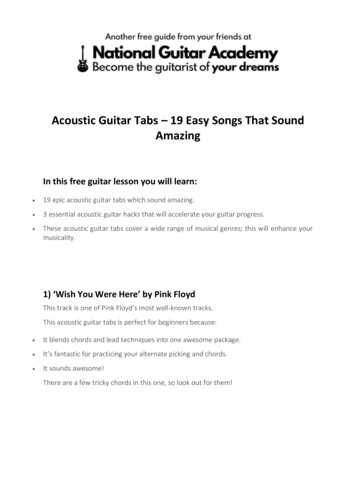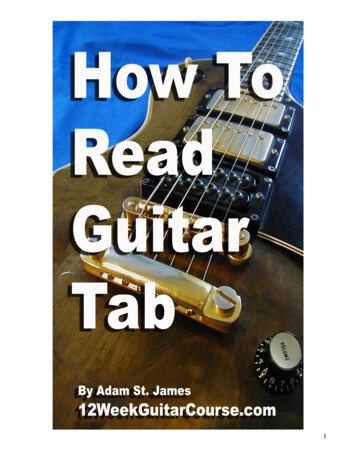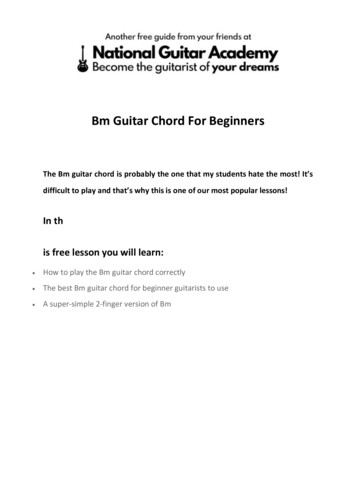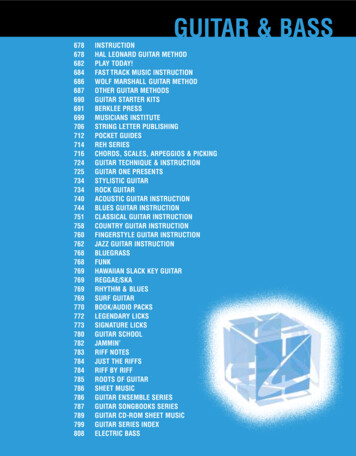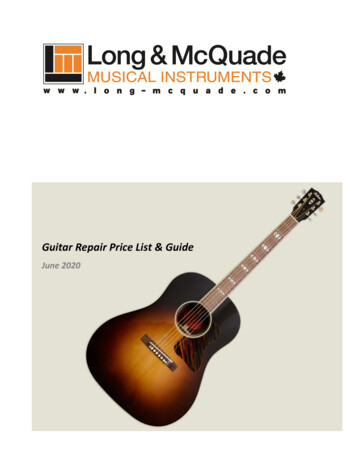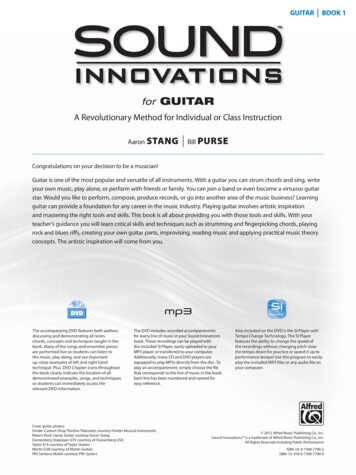
Transcription
GUITAR BOOK 1for GUITARA Revolutionary Method for Individual or Class InstructionAaron STANG Bill PURSECongratulations on your decision to be a musician!Guitar is one of the most popular and versatile of all instruments. With a guitar you can strum chords and sing, writeyour own music, play alone, or perform with friends or family. You can join a band or even become a virtuoso guitarstar. Would you like to perform, compose, produce records, or go into another area of the music business? Learningguitar can provide a foundation for any career in the music industry. Playing guitar involves artistic inspirationand mastering the right tools and skills. This book is all about providing you with those tools and skills. With yourteacher’s guidance you will learn critical skills and techniques such as strumming and fingerpicking chords, playingrock and blues riffs, creating your own guitar parts, improvising, reading music and applying practical music theoryconcepts. The artistic inspiration will come from you.DVDThe accompanying DVD features both authorsdiscussing and demonstrating all notes,chords, concepts and techniques taught in thebook. Many of the songs and ensemble piecesare performed live so students can listen tothe music; play along, and see importantup-close examples of left and right handtechnique. Plus, DVD Chapter icons throughoutthe book clearly indicate the location of alldemonstrated examples, songs, and techniquesso students can immediately access therelevant DVD information.The DVD includes recorded accompanimentsfor every line of music in your Sound Innovationsbook. These recordings can be played withthe included SI Player, easily uploaded to yourMP3 player or transferred to your computer.Additionally, many CD and DVD players areequipped to play MP3s directly from the disc. Toplay an accompaniment, simply choose the filethat corresponds to the line of music in the book.Each line has been numbered and named foreasy reference.Cover guitar photos:Fender Custom Shop Thinline Telecaster courtesy Fender Musical InstrumentsRobert Ruck Classic Guitar courtesy Aaron StangDuesenberg Starplayer GTV courtesy of Duesenberg USATaylor 614 courtesy of Taylor GuitarsMartin D28 courtesy of Martin GuitarsPRS Santana Model courtesy PRS GuitarsAlso included on the DVD is the SI Player withTempo Change Technology. The SI Playerfeatures the ability to change the speed ofthe recordings without changing pitch-slowthe tempo down for practice or speed it up toperformance tempo! Use this program to easilyplay the included MP3 files or any audio file onyour computer. 2012 Alfred Music Publishing Co., Inc.Sound Innovations is a trademark of Alfred Music Publishing Co., Inc.All Rights Reserved including Public PerformanceISBN-10: 0-7390-7790-2ISBN-13: 978-0-7390-7790-0
2CONTENT SUMMARYThis book focuses on real-world guitar skills such as chords, strumming, fingerpicking, rock and bluesriffs, creating guitar parts, improvising, reading music, and practical music theory. This content summaryprovides an easy-to-reference overview of the general learning sequence of skills and concepts.LEVEL 1Notes: E, F, G (6th string); A, B, C (5th string)4 3Rhythms: q, h, e, w , hk, 4 , 4Chords: E, Am, and Em; “specialty chords” F Flamenco, G Flamenco, Dm/A and Bm/ATechnique & Skills: downstroke ( ), strumming, fingerpicking, brush stroke ( )Terms & Symbols: accidentals, # , b , n , U, 1st position, 2nd position, repeat signs, 1st and 2nd endings,block chord, arpeggio4Rhythm Guitar Patterns: basic 4 fingerpicking patternMusic Styles: Flamenco, blues, acoustic fingerstyleRepertoire: Acoustic FantasyLEVEL 2Notes: D, E, F (4th string); G, A (3rd string)Chords: E7, G, C, D, A5, A6, D5, D6, E5, E6Terms & Symbols: chromatic, half step, tonic, key signature, tie,Technique & Skills: palm muteŒ, , blues song form, power chord, tie3Rhythm Guitar Patterns: boogie pattern in A; fingerpicking patterns in 4Music Styles: Flamenco, bass-line blues riffs, blues boogie, acoustic fingerstyle, folkRepertoire: The Blues Boogie RhythmPlaisir d’AmourLEVEL 3Notes: B, C, D (2nd string); E, F, G (1st string)Rhythms: q kTerms & Symbols: accent, ritardando, blues licks, improvise, lickTechnique & Skills: alternate picking, hammer-on, pull-off, slide, improvisation3Rhythm Guitar Patterns: One-grip blues, blues boogie in A; fingerpicking patterns in 4Music Styles: traditional, flamenco, classical, acoustic fingerstyle, blues-rockRepertoire: Amazing GraceFlamenco MoodOde to JoyOne Grip Blues
3LEVEL 4Chords: G7Rhythms: swing eighth notesTerms & Symbols: major, minor, dominant 7, (fi), D.S. al Coda, To Coda, a tempo, swing feel, staccato, blue notesTechnique & Skills: playing by earMusic Styles: folk and American traditional, classical, jazzRepertoire: Simple GiftsFür EliseWhen the Saints Go Marchin’ InLEVEL 5Chords: G7 (new form), D/F # , A7, D7, FRhythms:‰Terms & Symbols: roots music, shuffle, barreTechnique & Skills: shuffle rhythmRhythm Guitar Patterns: three-chord rock and roll, alternating thumb, blues shuffleMusic Styles: rock and roll, roots music, blues shuffleRepertoire: Corinna, CorinnaA Blues ShuffleLEVEL 6Rhythms:f F , p , P , tripletsTerms & Symbols: dynamics, ,Chords: Dm, B7Music Styles: classical, blues-rock, Spanish-classical, American traditionalRepertoire: Minuet in GAguado StudyOne Finger BluesRomanzaSimple GiftsAPPENDIX 1: Parts of the GuitarAPPENDIX 5: Tuning the GuitarAPPENDIX 2: Guitar TypesAPPENDIX 6: Reading Music and Tablature NotationAPPENDIX 3: Holding the GuitarAPPENDIX 7: Reading Rhythm NotationAPPENDIX 4: Technique and Warm-Up Exercises
4Level 1: Notes on the 6th and 5th StringsSee appendix 6 for a complete overview of music notation and tablature.DVD1FIRST NOTES: E, F, and G—These notes are on the 6th string.2EFGOpen1st Finger1st Fret3rd Finger3rd FretQUARTER NOTE q 1 count (1 )HALF NOTE h 2 counts (1 2 )44 TIME SIGNATURE4 Four counts per measure4 A quarter note receives one countTECHNIQUE Left hand: To produce the best tone with the least Right hand: Play all notes with a DOWNSTROKE of thepick . Strike the string with a downward attack, towards amount of pressure, place your fingertip directlybehind the fret, but not on top of it.the floor, coming to rest on the 5th string. The termSIMILE means to continue playing in the same manner. 234FIRST NOTES—Listen as your teacher counts and plays E, F, and G notes, then echo back each measure.(Count “1 and 2 and 3 and 4 and.”)
5A CHORD is three or more notes played at the same time. Guitarists often play combinations of chords and single notes.DVD5FIRST CHORD: E—To play the E chord, place your fingers as shown in the diagram, and strum through all six strings following theinstructions below. (See appendix 6 for how to read chord diagrams.)3Notice that the lowest note of the E chord (the open 6thstring) is E, which is also the name of the chord. Thenote or letter name of any chord is called the ROOT.To STRUM the E chord, position your pick on the low E string,holding it with a very relaxed grip, and allow your hand to fallthrough all six strings, stopping after it passes through thefirst string (closest to the floor). Then return to astrum again.Don’t push your hand through; just allow it to drop through thestrings to create a single, even sound, not six separate notes.RHYTHM SLASHES ( ) indicate rhythm withoutshowing pitch. They are often used in conjunctionwith chord diagrams to indicate the rhythmic strumpattern for the chords.6FIRST STRUM—This exercise introduces the E chord.7MOVING CHORDS—Slide the E shape up one fret and play all six strings to create a very interesting chord we will call F Flamenco.Make sure your fingers maintain the E shape as you slide up the strings. Playing all six open strings gives us a chord we will callG Flamenco. These two Flamenco-style chords are not “standard” guitar chord forms, but they sound great and are used inFlamenco guitar.DVD84
36Level 5: Three-Chord Rock and BluesTHREE-CHORD ROCK AND ROLLLike the blues progression, many rock songs are based on just the I, IV, and V chords. The following common threechord rock and roll chord pattern is found in countless songs including, “Wild Thing,” “Hang On Sloopy,” “Twist andShout,” “Louie, Louie,” “La Bamba,” “Get Off of My Cloud,” “Good Lovin’,” “Love Is All Around,” and “You’ve Lost ThatLovin’ Feeling.”Tip: It’s important to understand that all songs have many things in common, so whenever you learn a chord progressionor standard rhythm pattern for one song, you are actually learning something that will apply to many, many other songsyou play.KEY SIGNATURES1 sharp (F #) Key of G2 sharps (F # , C # ) Key of D3 sharps (F # , C # , G # ) Key of AAn eighth rest equals an eighth note: ‰ e66THREE-CHORD ROCK AND ROLL IN G—This progression is excellent practice for learning to change chords in tempo.DVD3267THREE-CHORD ROCK AND ROLL IN D—This example introduces an A chord. Use the indicated fingering.68THREE-CHORD ROCK AND ROLL IN A—Here is the same common progression in the key of A. Sometimes there are common fingerswhen changing from one chord to another. Look for those and use the same fingers wherever possible. When playing the A chord, your 1st finger is on the 3rd string. Don’t lift it as you change to the D chord. As you change from the D chord to the E chord, you can keep your 1st finger on the string, but slide it backwards one fret so it is inposition to play the E chord. Then, place your 2nd and 3rd fingers down.
Music Styles: classical, blues-rock, Spanish-classical, American traditional Repertoire: Minuet in G Aguado Study One Finger Blues Romanza Simple Gifts APPENDIX 1: Parts of the Guitar APPENDIX 2: Guitar Types APPENDIX 3: Holding the Guitar APPENDIX 4: Technique and Warm-Up Exercises APPENDIX 5: Tuning the Guitar
